1993 CHEVROLET SUBURBAN fuel
[x] Cancel search: fuelPage 224 of 386
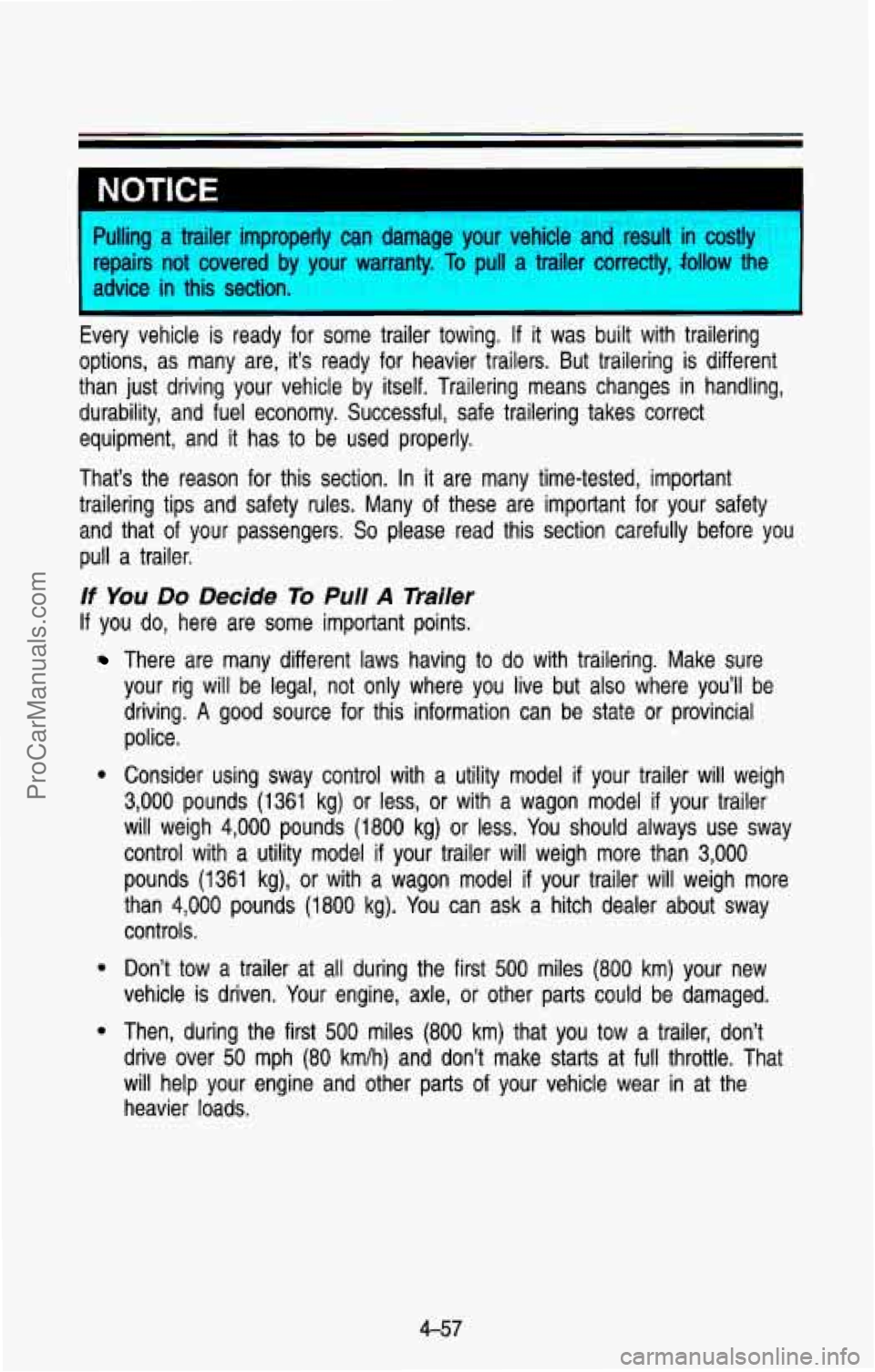
I NOTICE
’
I advice in this section.
Wing a trailer improperly can damage your vehicle and result in costly
epairs not covered by your warranty. To pull a trailer correctly, follow the
Every vehicle is ready for some trailer towing,
If it was built with trailering
options, as many are, it’s ready for heavier trailers. But \
trailering is different
than just driving your vehicle by itself. Trailering means changes in handling,
durability, and fuel economy. Successful, safe trailering takes \
correct equipment, and it has to be used properly.
That’s the reason for this section. In
it are many time-tested, important
trailering tips and safety rules. Many of these are important for your safety
and that of your passengers,
So please read this section carefully before you
pull a trailer.
If You Do Decide To Pull A Trailer
If you do, here are some important points.
e
e
There are many different laws having to do with trailering. Make sure
your rig
will be legal, not only where you live but also where you’ll be\
driving.
A good source for this information can be state or provincial
police.
Consider using sway control with a utility model
if your trailer will weigh
3,000 pounds (1361 kg) or less, or with a wagon model if your trailer
will weigh
4,000 pounds (1800 kg) or less. You should always use sway
control with a utility model
if your trailer will weigh more than 3,000
pounds (1 361 kg), or with a wagon model if your trailer will weigh more
than
4,000 pounds (1800 kg). You can ask a hitch dealer about sway
controls.
Don’t tow a trailer at all during the first
500 miles (800 km) your new
vehicle is driven. Your engine, axle, or other parts could be damaged.
Then, during the first
500 miles (800 km) that you tow a trailer, don’t
drive over
50 mph (80 kmlh) and don’t make starts at full throttle. That
will help your engine and other parts
of your vehicle wear in at the
heavier loads.
4-57
ProCarManuals.com
Page 247 of 386
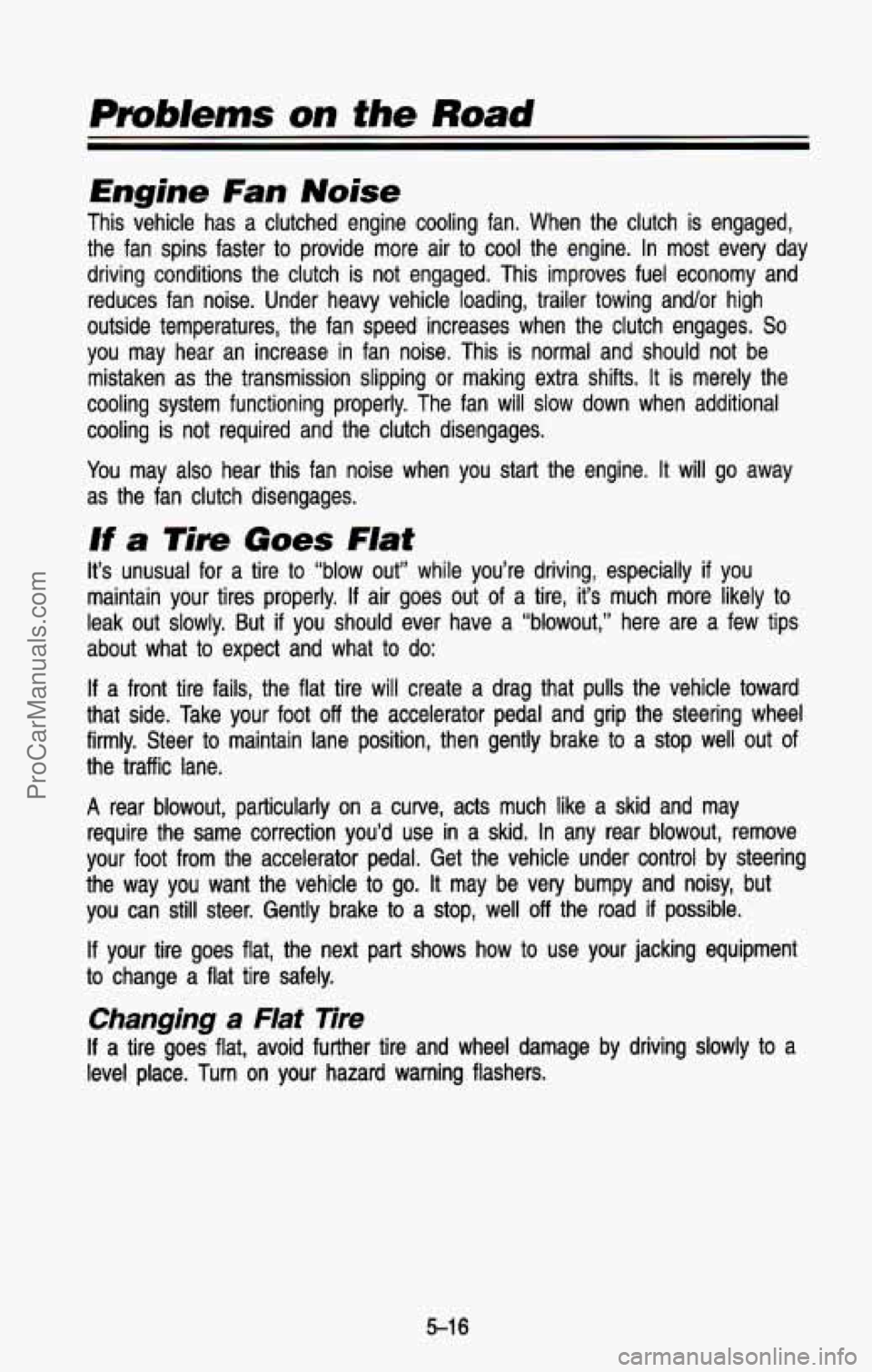
Engine Fan Noise
This vehicle has a clutched engine cooling fan. When the clutc\
h is engaged,
the fan spins faster
to provide more air to cool the engine. In most every day
driving conditions the clutch is not engaged. This improves fuel economy and
reduces fan noise. Under heavy vehicle loading, trailer towing \
and/or high
outside temperatures, the fan speed increases when the clutch e\
ngages.
So
you may hear an increase in fan noise. This is normal and sh\
ould not be
mistaken
as the transmission slipping or making extra shifts. It is merely the
cooling system functioning properly. The fan
will slow down when additional
cooling is not required and the clutch disengages.
You may also hear this fan noise when you start the engine. \
It will go away
as the fan clutch disengages.
If a Tire Goes Fiat
It’s unusual for a tire to “blow out” while you’re driving,\
especially if you
maintain your tires properly.
If air goes out of a tire, it’s much more likely to
leak out slowly. But if you should ever have a “blowout,” here are a few tips
about what
to expect and what to do:
If a front tire fails, the flat tire will create a drag that pulls the vehicle toward
that side. Take your foot
off the accelerator pedal and grip the steering wheel
firmly. Steer to maintain lane position, then gently brake
to a stop well out of
the traffic lane.
A rear blowout, particularly on a curve, acts much like a skid and may
require the same correction you’d use in a skid. In any rear blowout, remove
your foot from the accelerator pedal. Get the vehicle under co\
ntrol by steering
the way you want the vehicle
to go. It may be very bumpy and noisy, but
you can still steer. Gently brake to a stop, well off the road if possible.
If your tire goes flat, the next part shows how to use your jacking equipment
to change a flat tire safely.
Changing a Flat Tire
If a tire goes flat, avoid further tire and wheel damage by driving slowly to a
level place. Turn
on your hazard warning flashers.
5-1 6
ProCarManuals.com
Page 266 of 386
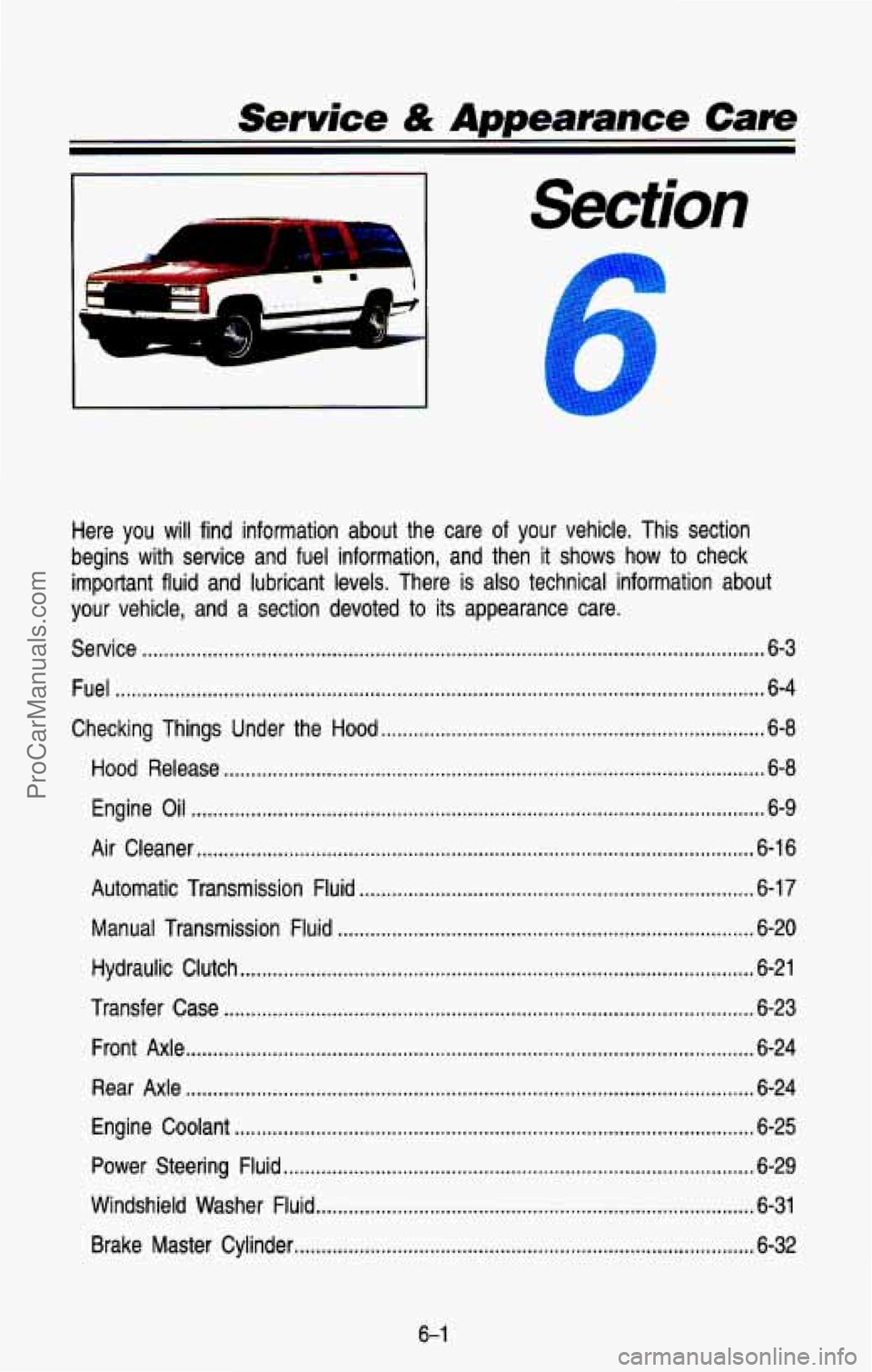
Service & Appearance Care
.
Here you will find information about the care of your vehicle . This section
begins with service and fuel information. and then it shows
how to check
important fluid and lubricant levels
. There is also technical information about
your vehicle. and a section devoted to its appearance care
.
Service ........................................................................\
........................................... 6-3
Fuel ........................................................................\
................................................ 6-4
Checking Things Under the Hood
....................................................................... \
6-8
Hood Release
........................................................................\
............................ 6-8
Engine Oil ........................................................................\
.................................. 6-9
Air Cleaner
........................................................................\
............................... 6-16
Automatic Transmission Fluid
........................................................................\
. 6-17
Manual Transmission Fluid ........................................................................\
..... 6-20
Hydraulic Clutch
........................................................................\
....................... 6-21
Transfer Case
........................................................................\
.......................... 6-23
Front
Axle ........................................................................\
................................. 6-24
Rear Axle
........................................................................\
................................. 6-24
Engine Coolant
........................................................................\
........................ 6-25
Power Steering Fluid
........................................................................\
............... 6-29
Windshield Washer Fluid
........................................................................\
......... 6-31
Brake Master Cylinder
........................................................................\
............. 6-32
6-1
ProCarManuals.com
Page 269 of 386

If you try to do your own service work without knowing enough about it,
your vehicle could be damaged.
I
Maintenance Schedule
Section 7 of this manual, “Scheduled Maintenance Services”, explains \
the
maintenance your new vehicle needs, and when
it should be done. It also
has a
form that you can use to record the maintenance work done on your
vehicle. Be sure to read this information.
Fuel
I K228
Use regular unleaded gasoline rated at 87 octane or higher. It should meet
specifications
ASTM D4814 in the U.S. and CGSB 3.5-92 in Canada. These
fuels should have the proper additives,
so you should not have to add
anything
to the fuel.
In the
US. and Canada, it’s easy to be sure you get the right kind of
gasoline (unleaded). You’ll see UNLEADED right on the pump. And only
unleaded nozzles will
fit into your vehicle’s filler neck.
Be sure the posted octane is at least
87. If the octane is less than 87, you
may get a heavy knocking noise when you drive. If it’s bad enough, it can
damage your engine.
6-4
ProCarManuals.com
Page 270 of 386
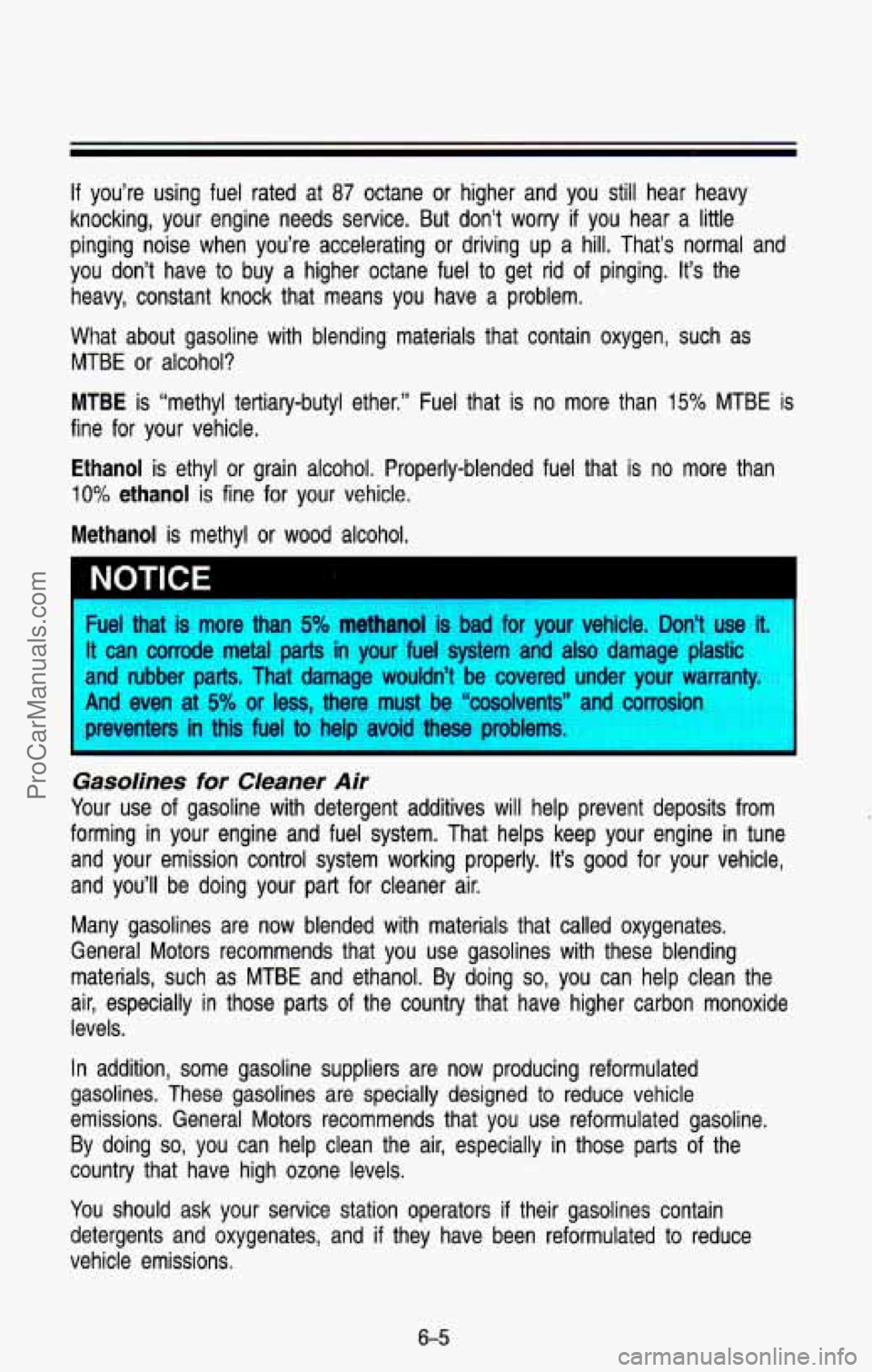
If you’re using fuel rated at 87 octane or higher and you still hear heavy
knocking, your engine needs service. But don’t worry
if you hear a little
pinging noise when you’re accelerating
or driving up a hill. That’s normal and
you don’t have to buy
a higher octane fuel to get rid of pinging. It’s the
heavy, constant knock that means you have
a problem.
What about gasoline with blending materials that contain oxygen,\
such as MTBE
or alcohol?
MTBE is “methyl tertiary-butyl ether.” Fuel that is no more th\
an 15% MTBE is
fine for your vehicle.
Ethanol is ethyl or grain alcohol. Properly-blended fuel that is no more than
10% ethanol is fine for your vehicle.
Methanol is methyl or wood alcohol,
NOTICE
Fuel that is more than 5% methanol is bad for your vehicfe. Don’t use ‘A
It can corrode metal parts in your fuel system and also damage plastic
and rubber
parts. That damage wouldn’t be covered under your warri ’y.
And even at 5% or less, there must be “cosolvents” and corrosion
eventers
in this fuel to help avoid these problems.
Gasolines for Cleaner Air
Your use of gasoline with detergent additives will help prevent depo\
sits from
forming in your engine and fuel system. That helps keep your engine in t\
une
and your emission control system working properly. It’s good \
for your vehicle,
and you’ll be doing your part for cleaner air.
Many gasolines are now blended with materials that called oxyge\
nates.
General Motors recommends that you use gasolines with these ble\
nding
materials, such as MTBE and ethanol. By doing
so, you can help clean the
air, especially in those parts of the country that have higher carbon monoxide
levels.
In addition, some gasoline suppliers are now producing reformulated \
gasolines. These gasolines are specially designed
to reduce vehicle
emissions. General Motors recommends that you use reformulated g\
asoline.
By doing
so, you can help clean the air, especially in those parts of the
country that have high
ozone levels.
You should ask your service station operators if their gasolines co\
ntain
detergents and oxygenates, and if they have been reformulated to reduce
vehicle emissions.
6-5
ProCarManuals.com
Page 271 of 386

Service & Appearance Care
Fuels in Foreign Countries
If you plan on driving in another country outside the US. or Canada,
unleaded fuel may be hard
to find. Do not use leaded gasoline. If you use
even one tank full, your emission controls won’t work well \
or at all. With
continuous use, spark plugs can get fouled, the exhaust system \
can corrode,
and your engine
oil can deteriorate quickly. Your vehicle’s three-way catalytic
converter and oxygen sensor will be damaged.
All of that means costly
repairs that wouldn’t
be covered by your warranty.
To check on fuel availability, ask an auto club, or contact a major oil
company
that does business in the country where you’ll be driving.
You can also write us at the following address for advice. Just tell us where
you’re
going and give your Vehicle Identification Number (VIN).
General Motors of Canada Ltd.
International Export Sales
Post Office Box 828
Oshawa, Ontario L1H 7N1, Canada
Fi/ling Your Tank
I PO444
The fuel cap is behind a hinged door on the left side of your vehicle. To take
off the cap, turn it slowly to the left (counterclockwise).
6-6
ProCarManuals.com
Page 272 of 386

A
Gasoline vapor is highly flammable. It burns violently, and that can
cause very bad injuries. Don’t smoke
if you’re near gasoline or
refueling your vehicle. Keep sparks, flames, and smoking materia\
ls
away from gasoline.
I.
c
PO485
A
If you get gasoline on you and then something ignites it, you\
could
be badly burned. Gasoline can spray out on you
if you open the fuel
filler cap too quickly. This spray can happen
if your tank is nearly
full, and
is more likely in hot weather. Open the fuel filler cap slowly
and wait
for any “hiss” noise to stop.
I Then unscrew the cap all the way.
When you put the cap back on, turn it to the right (clockwise) until you hear
a clicking noise.
I NOTICE
r
6-7
ProCarManuals.com
Page 274 of 386
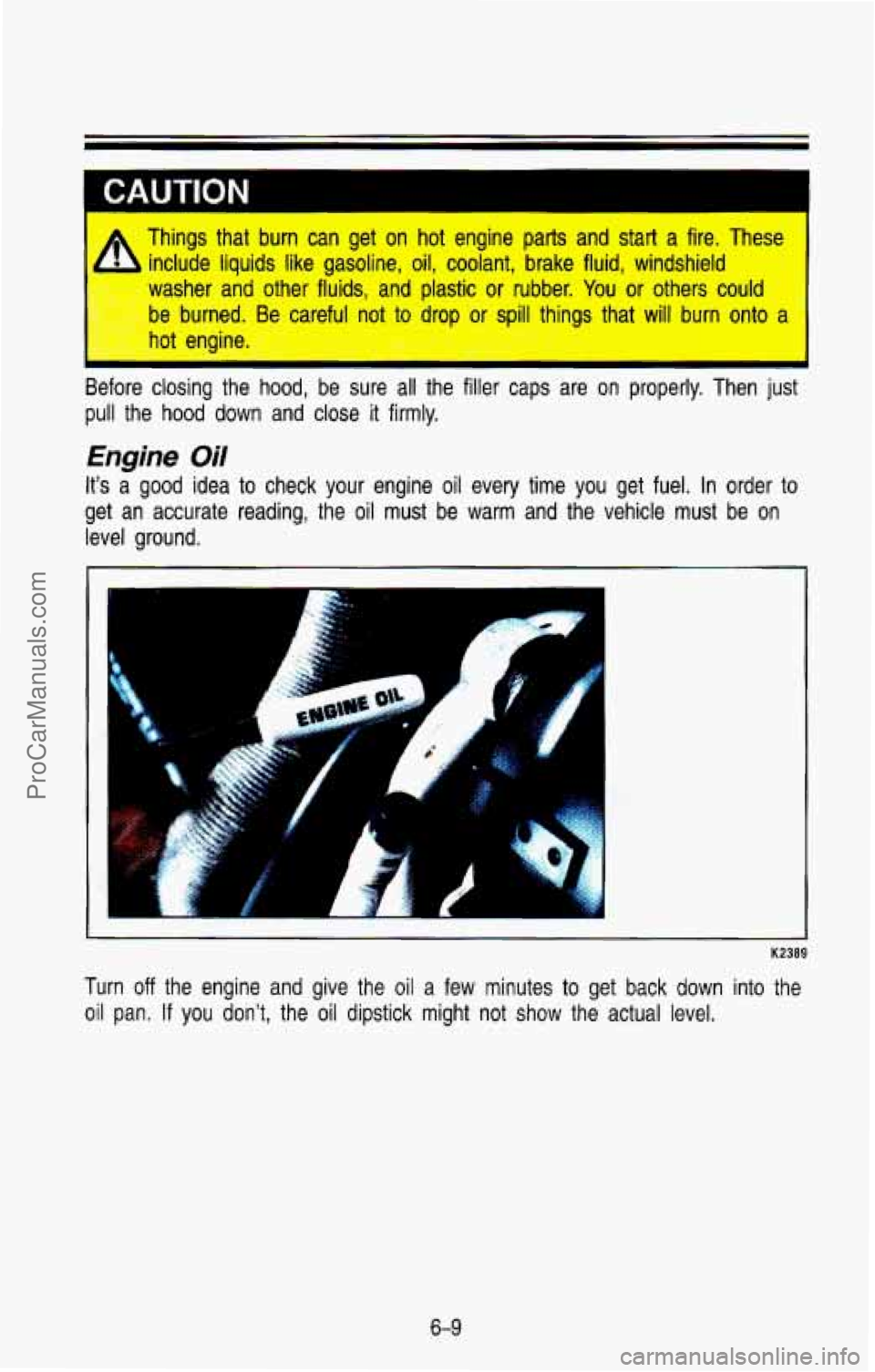
~AUTION
- Things that burn can get on hot engine parts and start a fire. These
include liquids like gasoline,
oil, coolant, brake fluid, windshield
washer and other fluids, and plastic or rubber.
You or others could
be burned. Be careful not to drop or spill things that will burn onto a
Before closing the hood, be sure
all the filler caps are on properly. Then just
pull the
hood down and close it firmly.
Engine Oil
It's a good idea to check your engine oil every time you get fuel. In order to
get an accurate reading, the
oil must be warm and the vehicle must be on
level ground.
Turn
off the engine and give the oil a few minutes to get back down into the
oil pan. If you don't, the oil dipstick might not show the actual level.
6-9
ProCarManuals.com